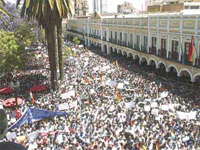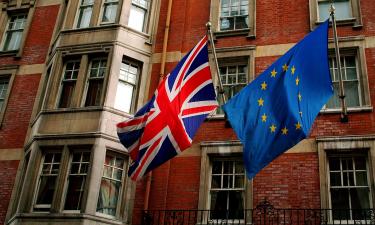Bolivia: Two cities fight for being the capital
The Constituent Assembly studies a proposal to move the seat of government from La Paz to Sucre. Hundred thousands marched to either support or protest the initiative.

Regional tensions in embattled Bolivia deepen as an assembly rewriting the country’s constitution discusses the status of the nine provinces that form the nation. Gas rich lowlands claim for more autonomy from the central power in the Andes highlands, as threat with secession if their demands are not satisfied.
Last week, an initiative to move the seat of government from La Paz in the highlands to the southern city of Sucre sparked massive demonstration to either support or protest the issue, which is being studies by the Constituent Assembly. At least 1 million filled the streets of La Paz, as hundreds of thousands marched in Sucre.
Rivalry between the two cities is long, as nowadays both are capitals of the Bolivian State. As La Paz holds the government and the Congress, Sucre is considered the historical capital of Bolivia and is the seat of the federal courts. Sucre a peaceful colonial town in the southern department of Chuquisaca, was the capital until 1899, when a liberal revolution moved it to La Paz. At that time, the highlands were the center of the mining production, the heart of the country’s economy.
Now, that the mining production has almost ceased, Sucre inhabitants, fuelled by the gas-rich lowlands departments of Pando, Beni, Tarija and Santa Cruz de la Sierra, want the seat of government back in town. La Paz, stronghold of President Evo Morales, resists.
In fact, the issue about the Bolivian Capital is far from being clear. After the country became an independent state from Spain in 1825, a law dated the same year ordered that the capital will be a city called Sucre, but at that time Sucre did not exist. As Chuquisaca was the most prosperous city of the country, and one of the most important educational centers of the world at that time, Bolivians renamed Chuquisaca after Marshall Sucre, a national hero born in Venezuela.
Quickly, La Paz emerged as an economical power and Sucre became a provincial town. In 1899, liberals defeated conservatives in a civil war and moved the capital to their stronghold in La Paz. Since then Sucre became the historical capital, but real power concentrated in the highlands.
The proposal to relocate the government to Sucre, a city of 250,000 people 700 kilometers southeast of La Paz, is backed by the rightist opposition that is concentrated in wealthier, eastern Bolivia. Supporters of the move say centrally located Sucre would provide a balance in the rivalry between east and west. Critics say changing the capital would cost billions of dollars. Some accuse the opposition of pushing the proposal to derail the constitutional reforms, a pillar of Morales' plans to empower the indigenous majority concentrated in the west.
The debate has been dominating newspaper editorials and radio phone-in shows. Leaders of Sucre's campaign say they have strong support in many parts of Bolivia. "We'll go to every corner of the country to defend our proposal. The people have to know we're not looking for division, rather a way to unite the country," Jaime Barron, a civil leader from Sucre, told La Prensa newspaper. Despite that confidence, an opinion poll in the paper La Razon on Friday showed 66 percent of Bolivians oppose the move.
President Morales, concerned about regional tensions could lead to the split of the nation, said that the issue should not be discussed at the Assembly.
At least four of nine Bolivian departments demand more autonomy from central power, proposing Spain’s model to secure regional self-determination without threatening the national union. However, inside this movements, radical wings demand total independence, which in fact means the split of the South American country. These groups are backed by powerful businessmen who oppose Evo Morales leftist rule.
Last week, civic leaders of the southern department of Tarija, which concentrates 85 percent of the country’s natural gas reserves, called a popular assembly to discuss autonomy from La Paz. Tarija is a southern department that opted for joining prosperous Bolivia in 1835 after rejecting a proposal to become part of then-embattled Argentina.
Many Chapacos, as Tarija inhabitants are known, believe that as they once freely joined Bolivia, they could freely leave it now. Their future, as well as the one of the entire nation, depends on how leaders handle an issue that could get out of control.
Hernan Etchaleco
Subscribe to Pravda.Ru Telegram channel, Facebook, RSS!





